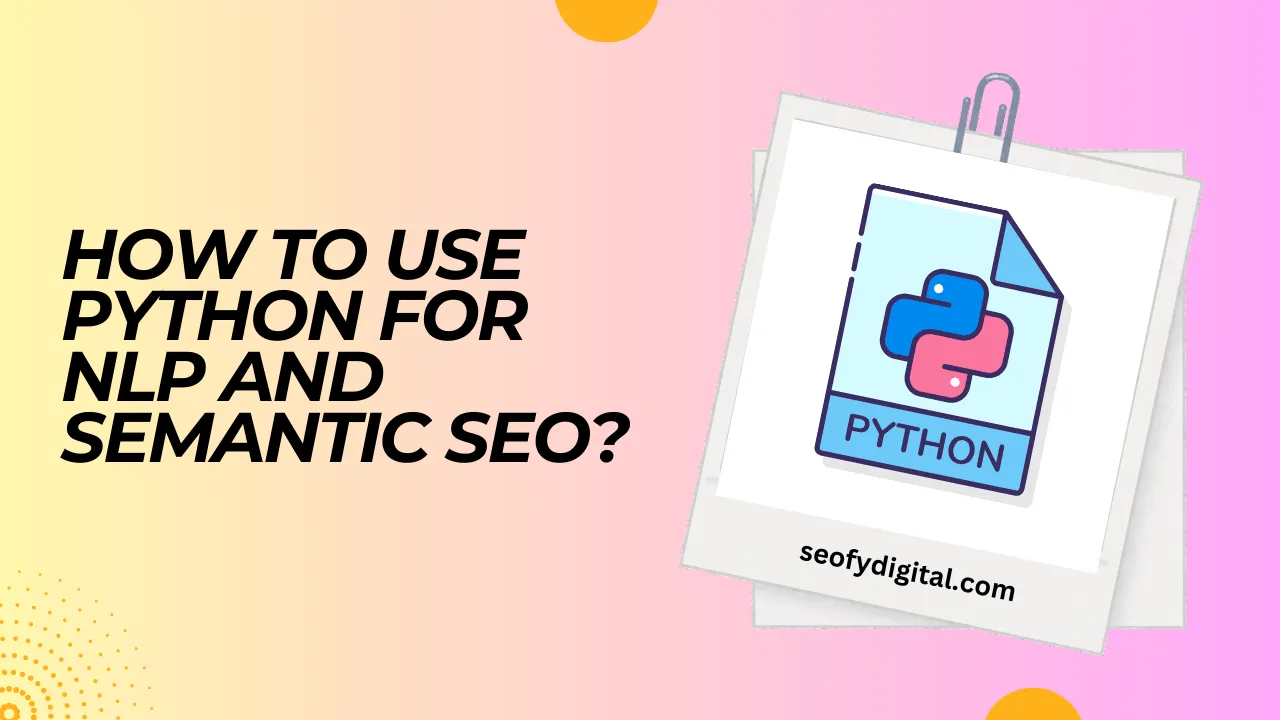In the constantly evolving world of digital marketing, staying ahead of the competition means embracing cutting-edge tools and techniques. One such powerful combination is Python and its applications in Natural Language Processing (NLP) and Semantic SEO.
These two fields, when merged, offer a dynamic approach to enhancing your website’s visibility and relevance in search engine results. By understanding how to leverage these technologies, you can create content that not only ranks higher but also resonates more deeply with your audience.
What makes Python so special in the world of NLP and SEO? It’s not just a programming language, but a versatile tool capable of transforming vast amounts of data into actionable insights.
With libraries like NLTK, spaCy, and Transformers, Python allows you to process and analyze language in ways that were once too complex for most digital marketers. This capability can help you fine-tune your SEO strategy by targeting the semantic meaning behind words rather than just the keywords themselves.
As we delve deeper into the practical aspects of using Python for NLP and semantic SEO, you’ll discover how these technologies can streamline tasks like text preprocessing, sentiment analysis, and even semantic search. By the end of this article, you’ll have the knowledge to use Python effectively, making your SEO efforts smarter and more precise.

Contents
Understanding NLP and Semantic SEO
Natural Language Processing (NLP) is the technology behind how computers understand, interpret, and generate human language. It encompasses a range of tasks from text classification to machine translation, which are essential in extracting meaningful insights from large datasets.
Python plays a significant role in NLP, making it easier to automate processes like tokenization, stemming, and named entity recognition (NER), all of which are crucial for optimizing content for both search engines and human readers.
On the other hand, Semantic SEO goes beyond simple keyword matching. It focuses on understanding the context and meaning behind the words in your content. This helps search engines deliver results that align with what users are actually searching for, not just what they typed.
Python’s NLP libraries help in analyzing not just keywords, but also the semantics behind the content, which is the future of SEO. Instead of focusing solely on ranking for specific keywords, semantic SEO ensures that your content answers user queries in the most relevant way possible.
Together, NLP and semantic SEO offer a powerful toolkit for improving the quality and visibility of your content. They enable you to move beyond traditional keyword-based SEO strategies and tap into the deeper, more nuanced aspects of language that can set your content apart from the competition.
Practical Applications of Python for NLP and Semantic SEO
Text Preprocessing
Text preprocessing is the first step in any NLP task. It involves tokenizing the text into words or phrases, followed by removal of stop words, and then stemming or lemmatization to reduce words to their root form.
Python libraries like NLTK and spaCy make this process quick and efficient, enabling you to clean and prepare data for further analysis. This step ensures that your content is analyzed for its true meaning, rather than focusing on irrelevant words.
Sentiment Analysis
Sentiment analysis is a powerful way to understand user emotions and feedback from text data. By analyzing customer reviews or social media mentions, you can gain insights into whether the general sentiment is positive, negative, or neutral.
Python’s robust NLP libraries allow you to perform this analysis with ease, helping you adjust your content and SEO strategies based on user perceptions. This is crucial for brands looking to manage their online reputation and ensure customer satisfaction.

Named Entity Recognition (NER)
Named Entity Recognition (NER) is the process of identifying specific entities in a text, such as people, organizations, locations, or dates. For SEO, understanding these entities can be extremely valuable.
By leveraging Python, you can automate the process of extracting these entities and using them strategically within your content. This not only makes your content more relevant but also improves its chances of appearing in featured snippets or knowledge graphs on search engines.
Text Summarization
Creating concise, accurate summaries of long documents is essential for both SEO and user experience. Python’s NLP capabilities allow you to generate meta descriptions, abstracts, and shortened content that maintain the original meaning but in a more digestible format.
This is particularly useful for improving click-through rates and providing users with a quick overview of your content.
Topic Modeling
Topic modeling helps you understand the underlying themes within a set of documents. By using Python’s Gensim library, you can analyze large volumes of text and identify patterns or themes. This helps in creating content clusters that are semantically related, allowing you to target a broader set of semantic keywords and improve your content strategy for better SEO performance.
Implementing Semantic SEO with Python
Keyword Research and Semantic Analysis
Using Python, you can analyze search queries to identify relevant keywords and semantic entities. Tools like Google Keyword Planner and SEMrush provide keyword data, but Python’s NLP tools take this a step further by analyzing the context in which these keywords appear. This allows you to identify terms that might not be obvious but are semantically connected to your core topic.
Content Creation and Optimization
Python can assist in creating and optimizing content for both search engines and human readers. By applying semantic analysis to your content, you can ensure that it contains the right balance of semantic keywords and related terms. Additionally, using schema markup with Python helps search engines better understand the context of your content, making it more likely to appear in rich snippets.
Link Building
Python’s ability to perform advanced NLP techniques also helps in link building. By analyzing websites for relevant content and identifying potential backlink opportunities, Python can automate the process of finding high-quality links that align with your niche. This is a valuable asset for building authority and improving your SEO performance.
Conclusion
Incorporating Python into your NLP and semantic SEO strategies can significantly enhance the effectiveness of your digital marketing efforts. With its rich library ecosystem, Python enables you to not only analyze and optimize text but also understand the underlying meaning and context behind words.
By mastering these techniques, you can create high-quality, contextually relevant content that appeals to both search engines and your target audience.
The future of SEO lies in the understanding of user intent, and with Python’s capabilities, you can take your SEO efforts to the next level. Keep experimenting, stay up to date with advancements in NLP, and continually refine your approach to achieve the best results.
FAQs
1. What is NLP, and how does it relate to SEO?
NLP (Natural Language Processing) enables computers to understand human language. In SEO, it helps optimize content by improving keyword relevance and semantic understanding of user queries.
2. How can Python help with semantic SEO?
Python, with libraries like spaCy and NLTK, can analyze text to understand context, identify semantic keywords, and optimize content for better search engine rankings.
3. What Python libraries are best for NLP?
The most popular Python libraries for NLP are spaCy, NLTK, Gensim, and Transformers. These libraries support various NLP tasks like text classification, NER, and sentiment analysis.
4. What is sentiment analysis in NLP?
Sentiment analysis involves determining whether a piece of text expresses a positive, negative, or neutral sentiment. It’s often used to analyze customer reviews and social media mentions.
5. How does named entity recognition (NER) help SEO?
NER identifies important entities like people, places, and brands in content, helping search engines better understand and index your content, which can improve visibility.
6. Can Python automate content summarization?
Yes, Python can automate the creation of meta descriptions and summaries using NLP techniques, making it easier to provide concise information that enhances user experience and SEO.








